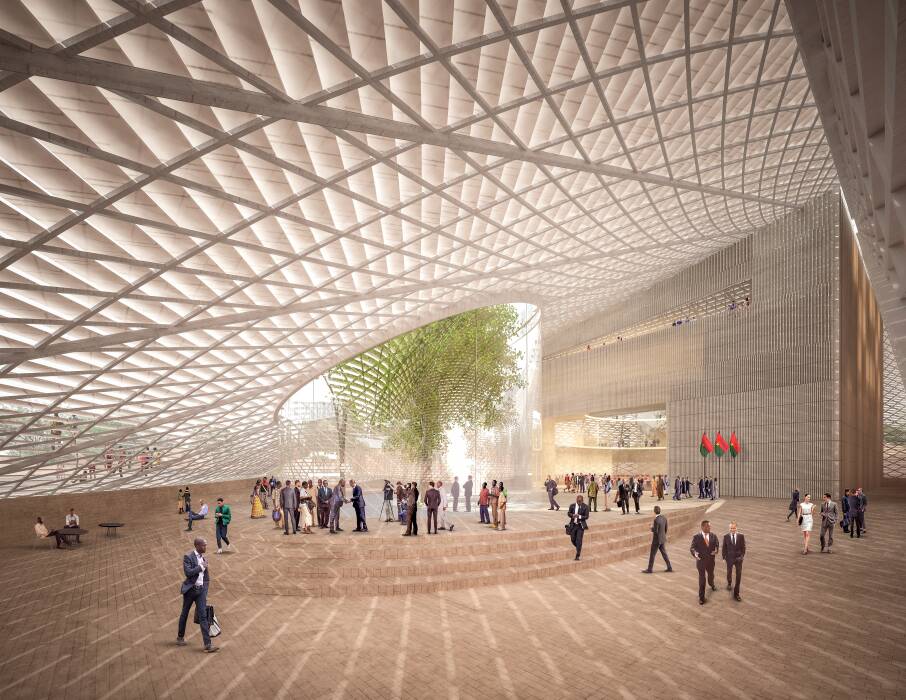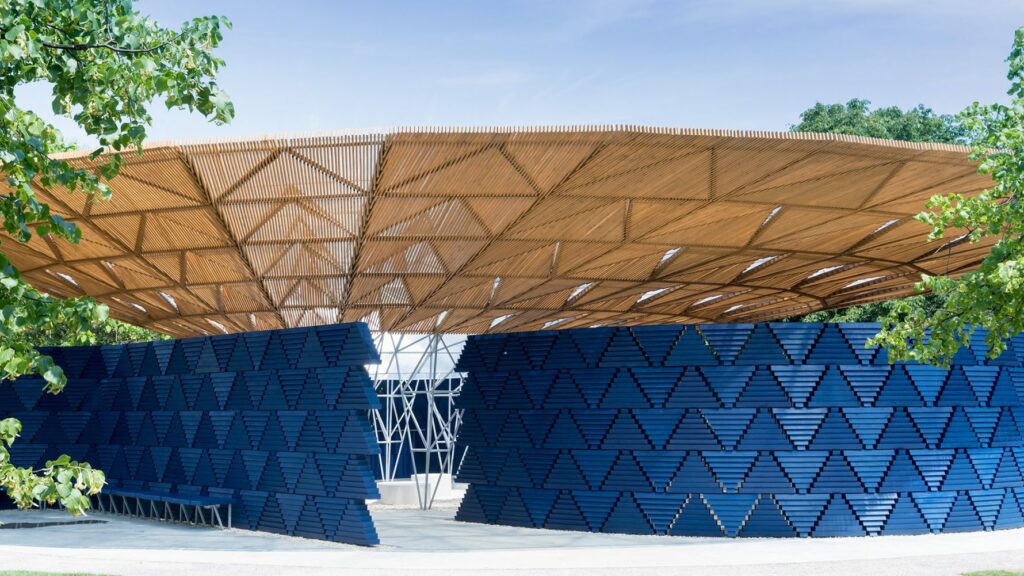



A 2-day immersion into the future of sustainable construction
Francis Kéré, a name that resonates with innovation and community within the architectural world, has transformed how we perceive the role of architecture in society. His approach intertwines the raw essence of traditional craftsmanship with cutting-edge design, making him a pivotal figure in the sustainable architecture dialogue.
Francis Kéré: Early Life and Education
The Journey Begins in Gando
Born in the small village of Gando in Burkina Faso, Francis Kéré was the first child in his village to attend school—an experience that profoundly shaped his understanding of educational and communal spaces. This early exposure to the limitations and potentials of educational environments in developing regions became the bedrock of his architectural ethos.
Table: Key Milestones in Kéré’s Early Life
| Year | Milestone |
|---|---|
| 1965 | Born in Gando, Burkina Faso |
| 1985 | Moves to Germany on a carpentry scholarship |
| 2004 | Graduates from Technische Universität Berlin |
Educational Pathways in Berlin
His scholarship to Germany was not merely a passage to formal education but a gateway to a world of possibilities. In Berlin, Kéré dove into the depths of architecture at the Technische Universität, where he blended his hands-on carpentry skills with academic rigor. This period was crucial in forming his unique architectural voice, one that values functionality, sustainability, and the empowerment of local communities.
Philosophical Foundations: Architecture as a Community Dialogue
Francis Kéré: More Than Buildings
For Kéré, architecture is not about creating monuments but about sparking conversations and fostering communities. His philosophy is rooted in the principle that architecture should be accessible, educational, and empowering. Each structure he designs is a response to the specific needs of its users, crafted with local materials and local hands.
Principles of Francis Kéré’s Architectural Philosophy
- Community Involvement: Engaging the community in the construction process to ensure the architecture serves its true purpose.
- Sustainability: Utilizing local, sustainable materials and techniques to minimize environmental impact.
- Education: Designing spaces that educate and elevate the community, transforming everyday interactions with architecture into learning opportunities.
Major Projects: Transforming Communities Through Design
Francis Kéré’s architectural projects span continents but share a common thread: they are deeply rooted in the needs and cultures of their communities. Here, we explore some of Kéré’s most transformative projects, each illustrating his commitment to sustainable, community-driven design.
Gando Primary School: The Project That Started It All


Photo by Simeon Duchoud.
The Gando Primary School in Burkina Faso is perhaps Francis Kéré’s most famous project, not just for its architectural ingenuity but for its profound social impact. Built with compressed earth bricks, the school is designed to be naturally cooling, addressing the harsh local climate while utilizing local materials and labor. This project not only provided a much-needed educational facility but also became a model for sustainable building practices in Africa.
The National Assembly of Burkina Faso: A Symbol of Resilience


Render by Kéré Architecture.
Unbuilt but visionary, the National Assembly project in Ouagadougou was commissioned after the 2014 uprising. It represents a new era for Burkina Faso, symbolizing transparency and democracy. The design features a stepped, pyramidal form that invites the public to climb its steps and view the city—an architectural embodiment of the people’s oversight over their government.
Serpentine Pavilion: Celebrating Community and Culture


Photograph © 2017 Iwan Baan
Francis Kéré’s design for the 2017 Serpentine Pavilion in London highlighted his ability to blend cultural narrative with functionality. The structure, inspired by the tree as a central meeting point in his hometown of Gando, featured a central oculus that funneled rainwater, celebrating the communal spirit in a public, international setting.
Innovative Use of Materials: Merging Local Traditions with Modern Techniques
Francis Kéré is renowned for his innovative use of local materials, which not only reduces the carbon footprint but also boosts local economies by employing area craftsmen and materials.
Earth Bricks: Reviving Traditional Techniques
In multiple projects, Kéré has utilized locally made earth bricks, a method that is both sustainable and culturally significant. This technique not only keeps buildings cooler but also involves the community in the building process, making each project a collective endeavor.
List: Benefits of Earth Bricks
- Environmental Impact: Lowers emissions compared to conventional materials.
- Cost-Effective: Reduces costs by using locally sourced materials.
- Community Engagement: Involves local people in the construction, enhancing skills and providing jobs.
Innovative Ventilation Systems: Natural Cooling
In the harsh climates of Burkina Faso, Francis Kéré’s designs often incorporate passive cooling systems, such as the large overhanging roofs and carefully designed ventilation openings in the Gando School. These features allow air to circulate naturally, creating a comfortable indoor environment without the need for energy-intensive air conditioning.
Community Engagement: The Heart of Kéré’s Architecture
Francis Kéré’s projects go beyond mere buildings; they are vibrant hubs of community life, designed with the participation of the people they serve. This section delves into how Kéré’s engagement with local communities is integral to his design process and the sustainability of his architectural works.
Participatory Design: Empowering Communities
Francis Kéré’s architectural practice is distinguished by its focus on participatory design—a method that involves the community at every stage, from planning to construction. This approach not only ensures that the projects are well-suited to the local needs but also fosters a sense of ownership and pride among the residents.
Francis Kéré and Key Projects Featuring Community Participation
- Gando Primary School: Residents contributed to building techniques and materials, gaining skills and employment.
- Serpentine Pavilion: Inspired by the communal use of space in his hometown, it became a place for gathering and social interaction in an international context.
Building Capacity: Training and Employment
In many of his projects, Kéré has set up training programs for local workers, teaching them construction skills that they can use to improve their livelihoods long after the project’s completion. This strategy has turned architectural projects into catalysts for economic development within these communities.
Global Impact: Spreading the Architectural Philosophy
Francis Kéré’s influence extends far beyond the villages of Burkina Faso. His commitment to sustainable and community-focused architecture has set a global benchmark, inspiring projects and architects around the world.
Francis Kéré Spreading Sustainable Practices
Kéré’s approach to using local materials and community-engaged processes has influenced architectural practices in various parts of the world, promoting sustainability and social responsibility in building designs.
International Recognition and Collaboration
Kéré’s work has garnered international acclaim, leading to collaborations with global architects and institutions which further spread his philosophy of integrating architectural practice with social and environmental considerations.
Francis Kéré Notable Collaborations and Influences
- Harvard and Yale: Teaching positions at these prestigious universities allow Kéré to share his philosophy with the next generation of architects.
- Venice Biennale: His installations at this international exhibition have showcased his methods and designs to a global audience.
Francis Kéré’s architectural journey shows that good design is not just about creating spaces but about nurturing the people who live and work within them. His global impact is a testament to the power of integrating local traditions with innovative practices to create sustainable and meaningful architecture.
Awards and Recognitions: Celebrating Architectural Excellence
Francis Kéré’s innovative and community-focused approach to architecture has not only transformed communities but also earned him numerous prestigious awards. This section explores the significant accolades that highlight Kéré’s contributions to the field of architecture.
Pritzker Architecture Prize
In 2022, Francis Kéré was awarded the Pritzker Architecture Prize, often regarded as the Nobel Prize of architecture. This award recognized his continuous commitment to creating designs that are both economically sustainable and culturally sensitive. The jury praised his ability to beautifully marry local building traditions with modern technology to serve the community’s needs.
Selected Awards and Honors
- Aga Khan Award for Architecture: For the Gando Primary School, commending its innovative use of local materials and community involvement.
- Global Award for Sustainable Architecture: Recognizing his holistic approach to sustainable building practices that extend beyond environmental considerations to social impact.
Educational Contributions: Shaping the Next Generation of Architects
Francis Kéré’s role as an educator and mentor is pivotal in disseminating his architectural philosophies. His academic positions and public engagements allow him to influence future architects and planners around the world.
Francis Kéré: Teaching at Prestigious Institutions
Kéré has held teaching positions at some of the world’s leading universities, including the Harvard Graduate School of Design and the Yale School of Architecture. Here, he integrates his practical experiences with academic theory, providing students with real-world insights into sustainable and socially responsible architectural practices.
Impact on Students and Young Architects
Through his teaching and public speaking engagements, Kéré has mentored thousands of students who carry forward his ideals into their own architectural practices. His influence is evident in the increasing number of architectural projects globally that emphasize community involvement and sustainability, mirroring his teachings.
Francis Kéré’s educational contributions ensure that his legacy will continue to impact the field of architecture far into the future, promoting a continuous evolution towards more sustainable and community-centered design practices.
Future Directions: Envisioning Tomorrow’s Architecture
Francis Kéré’s work continually evolves, addressing new challenges and exploring further opportunities to impact communities through architecture. This section outlines his plans for future projects and ongoing contributions to the architectural field.
Francis Kéré Upcoming Projects
Kéré’s future projects reflect his ongoing commitment to sustainability and community empowerment. These projects not only aim to address the practical needs of their users but also to serve as educational and cultural landmarks.
Table: Kéré’s Upcoming Architectural Projects
| Location | Project | Focus |
|---|---|---|
| Burkina Faso | Advanced Educational Complex | Education & Community |
| Germany | Eco-Friendly Urban Development | Sustainable Urban Living |
| United States | Cultural Exchange Pavilion | Art & Community Interaction |
Francis Kéré: Vision for Sustainable Architecture
Kéré envisions a future where architecture fully embraces sustainability—not just environmentally, but also socially and economically. His approach suggests a model where buildings serve as catalysts for community development and cultural preservation.
Conclusion: Building a Legacy of Sustainable and Community-Driven Architecture
Francis Kéré’s architectural philosophy represents a profound shift in how buildings are conceived and constructed. His focus on community engagement, sustainable building practices, and educational outreach has not only changed landscapes but also lives. Through his innovative use of materials, inclusive design processes, and educational contributions, Kéré has established a legacy that will influence generations of architects.
The Impact of Francis Kéré’s Work
Kéré’s buildings are more than structures; they are vibrant community centers that promote learning, culture, and environmental sustainability. His work demonstrates that architecture can be an agent of social change, providing solutions to global challenges while respecting local traditions and environments.
Key Contributions of Francis Kéré’s Architectural Practice
- Community Development: Each project is tailored to enhance the social fabric of the community it serves.
- Sustainability: Pioneering the use of local, sustainable materials and techniques.
- Education: Through both his buildings and his teaching, Kéré educates and inspires.
Francis Kéré’s journey from a small village in Burkina Faso to the pinnacle of global architecture embodies a message of hope and transformation. His approach, grounded in respect for nature and humanity, offers a blueprint for future architects aiming to create meaningful and sustainable environments. As we look to the future, Kéré’s continuing influence on the architectural world promises further innovations that will enrich communities and ecosystems around the globe.
If you want o learn about our consultancies in Portuguese language, click here.






A 2-day immersion into the future of sustainable construction

